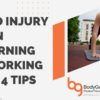Falling down can be a constant worry for seniors and others who have mobility challenges. Those worries aren’t unfounded as falls are the leading cause of injury-related deaths and serious health problems in the U.S.
Improving your walking skills — technically known as your “gait” — and your balance are interrelated challenges. Physical therapy will help you master both of these skills to decrease your risk of injury, while at the same time increasing your confidence and independence.
Balance: A Three-Legged Stool
Balance and gait are inextricably linked because they tend to impact one another. Even if you don’t think you’re in danger of falling down, the general slowing down you’re attributing to aging could be something else. Think of balance as a three-legged stool with the legs being eyes, ears, and feet. If one leg is missing, then the whole stool topples over.
Eyes: Have you ever noticed how much harder it is to balance in the dark or with your eyes closed? The first thing everyone uses to balance is vision. As we age our vision starts to deteriorate which makes us rely on our other senses even more. If you’re afraid of falling down, make sure you’ve had your eyes checked in the past year so your vision is the best it can be.
Ears: Have you ever felt the room spin? The vestibular system sits in your inner ears and tells you how your head is oriented and whether you’re accelerating or decelerating through space. If you experience chronic dizziness, your vestibular system likely needs help.
Feet: Do you feel unsteady? Proprioception is the sense of where your limbs are in space without having to look at them. A combination of receptors in your muscles and tendons, as well as the touch sensors in your skin, let your brain know what your feet are doing at all times. Some conditions, such as diabetes, can reduce the touch sensation in the bottoms of your feet, which means you need to rely on the receptors in your muscles and tendons, even more, to know where your feet are. Speaking of muscles, your feet, legs, and core also need the strength the be able to hold you upright.
What does balance and gait training entail?
First, we’ll evaluate your gait to determine where you aren’t moving efficiently. We’ll then test both your static and dynamic balance as well as your strength and range of motion. These basic evaluations will point us in the direction of what to focus on in terms of therapy.

If the problem is your eyes, we’ll focus on strengthening the other legs of the stool. If the problem is your ears, then vestibular rehab with a physical therapist will help make sure your system isn’t sending out faulty signals. If the problem is your feet, then we’ll make sure you have full range of motion to use your muscles efficiently before strengthening them and making sure they activate at the right time.
We’ll also do a variety of balance exercises that mimic obstacles you encounter in your everyday life. If you think more than one leg of your stool is in trouble, make sure you seek help now!
Ready to “balance” your life again?
Gait and balance training have a range of benefits, with avoiding injuries being at the top of the list. Beyond lessening your chances of falling or feeling dizzy, you’re also more likely to feel confident with your footing. In addition, any aches and pains you might have from poor posture are likely to decrease as well.
With our dedicated team of physical therapists behind you, you’ll regain confidence in navigating challenging terrain and learning how to avoid dizzy spells. You may even be able to leave that cane or walker behind!
Request Free Consult or Contact Us Today at Chicago Lincoln Park, Oak Brook, Oak Park, & Winnetka, IL Centers to regain your independence and learn more about how we can help you get back to enjoying life without fearing falling down.





